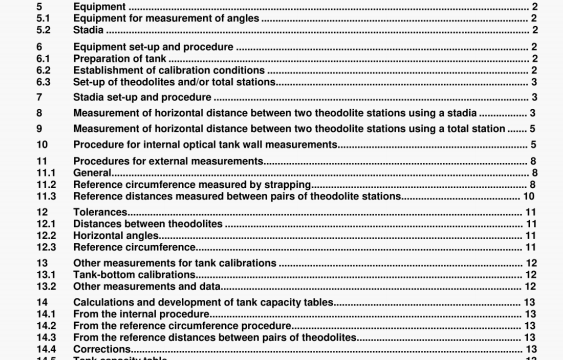BS ISO 07507-3 pdf download – Petroleum and liquidpetroleum products ——Calibration of verticalcylindrical tanks—— Part 3: Optical-triangulation method.
e) maximum fdlin9 height;
f) deaood;
g) number, width and thickness of any vertical welds or overlaps;
h) tilt of the tank as shown by the plumbline deviations;
I) shape, landing height and apparent mass ii air of any floating roof or cover
The velocity of sound in paint can be substantially different from its velocity in metal. When measuring thickness of paint, care should be taken to use proper instrumentation. e.g. echo-to-echo ultraso,c gauge. white following a suitable procedure Alternatively. it It Is necessary to scrape the paint, the thickness can then be measured by a single-echo ultrasonic gauge.
NOTE The average value and the range of tank shell temperatwes are required for uncertaivy analysis (see Annex A.),
13.2.2 It is necessary to refer each tank dip to the dip-point, which might be in a position different from the datum-point used for the purpose of tanlr calibration (e.g. a point on the bottom angle). Determine any difference In level between the datum.poinl and dlp.point and record It.
13.2.3 Measure the overall height of the reference point on each dip-hatch (iper reference point) above the dip-point using the dip-tape and dip-weight as specified in ISO 7507-1. Record this overall height, to the nearest millimetre. and permanently mark it on the tank adjacent to that dip-hatch
13.2.4 If possible, compare measurements with the corresponding dimensions shown In the drawings and venfy any measurement that shows a significant discrepancy.
13.2.5 Measurement of the temperature of the tank shell is important for correcting the measured radii at the time of tank calibration. Temperatures should be measured around the tank (at least at tour points), near the botlom of the shell and again near the top of the shell. Average temperatures should be used to correct the measured radii for
a) diflerential expansion of the tank shell and the stadia in the Internal method;
b) differential expansion of the tank shell between the strapped circumference and the rest of the tank in the reference circumference method;
C) general expansion of tanks at all heights in the reference distance method.
This annex describes calculations used in estimation of measurement uncertainties using the optical triangulation method for calibrating verlical cylindrical tanks
the calculations follow the guidelines set out in the GUil
As this part of ISO 7507 describes three ditferent measurement pnncles, the measurement uncertainties for the different principles are discussed separately In Clauses E.3 and E.4 These clauses describe uncertainty components that derive troni the measurement and calculation of the tank radius. The final tar* table is also based upon other measurement and calculahons The uncertainty components of these measurements and calculations are descflbed in ISO 7507-1
The uncertainty components descflbed can vary depending on the equipment and measurement conditions. Each measurement and its object are unique and it is necessary to evaluate the uncertainty components for each measurement separately.
The part of ISO 7507 describes three different 2-dimensional measurements. The procedures cto not give full 3-dimensional information. Uncertainties due to the fact that the measurements are not performed in a perfect plane (differences in height when sighting the points) are not considered ii this evakjation.
Any possible co-variances are disregarded.
BS ISO 07507-3 pdf download – Petroleum and liquidpetroleum products ——Calibration of verticalcylindrical tanks—— Part 3: Optical-triangulation method
